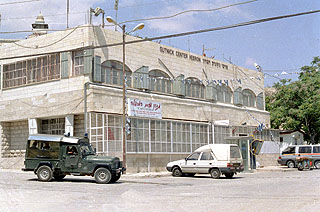
Once again I set off to Hebron, a city I have visited maybe 10 or 15 times now during the last eight years, in the wake of around three weeks of clashes that have resulted in hundreds of Palestinians and a few Israelis wounded. Left: Palestinian boy shot in the head with live ammunition during the clashes, © AFP
While all this was going on, Ramallah has been as quiet as a tomb, a not unusual situation that can be a little unhinging. The psychological feeling of perminance in this conflict has led to a fatigue that is only shaken off when the local pressures build up to overboiling point. This results in a strange, island-like separation of geographical moods, each only turning sour when all opportunity for the continuance of normal life evaporate. So, one town sleeps while another rises up. A few weeks later, they swop around, occasionally simultaneously exploding.
Outside the country, the ebbs and flows of the violence in the Israeli-Palestinian conflict are widely perceived to be homogenous and simulataneously occuring in the various areas but reality is more complex.
Sometimes, clashes may be errupting 400 metres down the road, while you're sitting at home eating breakfast. An hour later you may pass through the area and, like the surface of the sea one minute after the final thrashes of a drowning man, there is not a single ripple to speak of what happened.
For the different Palestinian towns to rise up as one, something major has to happen that affects the national consciousness, as we witnessed last September. The very silence of the other towns while Hebron raged has caused many discussions this last week as to why. My conclusion was that Hebron, unlike all of the other autonomous Palestinian cities and towns, is unique.

No other town has Israeli settlers in its midst. For the Palestinians in Hebron, every day the occupation remains in their faces. The power of a few people to control their lives is a daily chafing of a wound, the drip-drip-drip of the allegedly unresistable Chinese water torture that we described to each other in hushed tones around school summer campfires. Left: Settler information center and jeep near the Al-Haram Al-Ibrahimi Mosque.
Meanwhile, back on the way to Hebron, I am thinking that there might be clashes today, there might not. I am not going there to gawk at clashes, I am going to confront the message of Hebron from the recent comfort of Ramallah. I have realised that every time I approach Hebron, I feel a tightness around the pit in my stomach and we are talking moths, not butterflies, here.
I have only ever witnessed the really serious violence in Ramallah - where I live - and part of the reason for this physical manifestation of deep apprehension - apart from Hebron’s relatively unfamilliar territory - is the city’s power to carry on when all other resistance has petered out.
The settlers and the population both share at least two things in common. The first is that both - regardless of who may be right or wrong - have very fixed, negative positions about the other. The second is that both live right next to each other. This is a fatal mix, and one touched upon at the beginning of the Hebron Redeployment Diary.
Also, people get injured regularly in Hebron, including five Palestinian journalists this last week, something that sparked off a scathing condemnation from the Foreign Press Association here about deliberate targetting by Israelis.
Forget deliberate fire - accidential fire in Hebron has enough interesting twists of its own. The narrow streets of the Old City foment a kind of peculiar claustophobia that you don’t get in the open-plan killing fields of Ramallah’s Ma’alufiyyah. The heavy, metal, shop doors that line each side of its streets seem to be a pinball game waiting to happen, except that these steel balls ("rubber bullets") come at you 15 at a time, not gently bouncing off two flippers and safely enclosed under a glass cover.
As for bullets, my Hollywood myths about riccochets died a rapid death when I saw the storming of the Soviet parliament on TV. The footage was at night, and tracer bullets made clear the trajectory and speed of the rounds. The most shocking thing was the complete absense of velocity change before and after the rounds powered into the solid stone pavement outside the parliament doors.
Harbouring any thoughts about getting glanced in the leg by a rebound and being heroically stretchered away? Lose them now, as not only will the bullet be hitting you at almost the same speed, it’ll now be rolling end over end though the air, before it even reaches you. Getting shot before it starts to lose the corkscrew spin given to it by the rifled barrel has got to be preferable, assuming that it doesn’t hit you in the wrong place. Yep, you’re right. I have thought about this once or twice before.